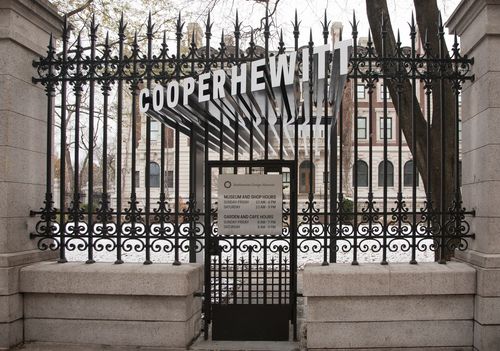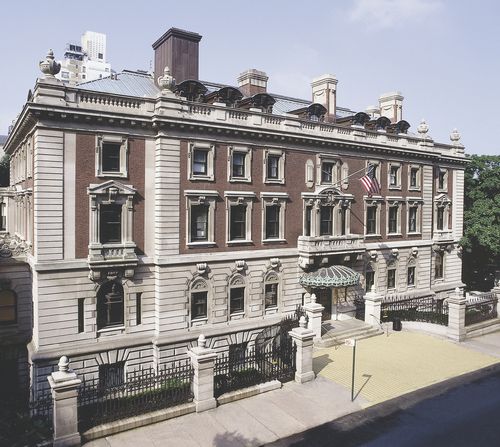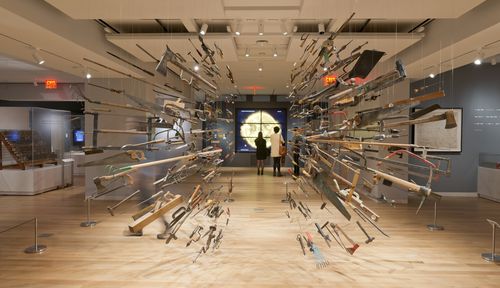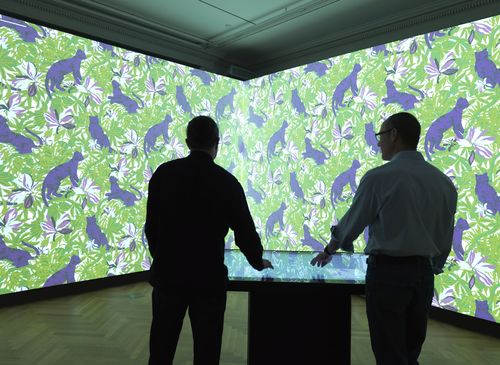THE NEW CRITERION, February, 2017
On the Gilder Center at the American Museum of Natural History, the Wagner Free Institute of Science in Philadelphia, and the lessons we can learn from older museums.
The best museums are often museums of museums—institutions that put their own history on display alongside their collections. The museums that fascinate me are never the buzziest models off the shelf but those that have been allowed to age. Either through conscious efforts at preservation or through the preservative fluids of neglect, such institutions invite us to experience history as a part of history. Rather than attempting to exist outside of themselves by erasing their past, museums that seem antiquated or even “out of date” can reflect the highest values of their mandates to protect and present the objects in their collections, which must include themselves.
The Metropolitan Museum of Art is of course one example of a museum that has preserved its own history better than most, something I wrote about in these pages in December. Even as it has evolved into more contemporary forms, the museum has worked to reveal the ornamental details of its architectural past—from the Victorian Gothic heart of its initial 1880 building by Calvert Vaux and Jacob Wrey Mould (now its gallery of Medieval art), through its many later additions in the Romanesque, Beaux-Arts, and modern styles.
Such a presentation can be even more revelatory in museums of science. Here older buildings and displays serve a vital and often overlooked role in teaching us about the history of instruction and inquiry. By seeing what older halls get right and wrong (or what we now believe to be right and wrong), we gain perspective on our own scientific certainties and the charismatic methods through which museums now present themselves to the modern public.
The American Museum of Natural History, the grand institution just across Central Park from the Metropolitan, and with a similar history, has likewise developed as an accumulation of buildings in a wide variety of styles. The institution has also been blessed with generations of naturalists and craftsmen who were the best in their scientific fields. History has borne that out, and we can continue to see it in the wondrous animal dioramas that have become the hallmark of the institution and have fascinated patrons across the ages (including this reviewer, beginning with almost weekly visits as a child).
After the naturalist and taxidermist Carl Akeley died in 1926 on the slopes of Mount Mikeno in the Belgian Congo while developing his Hall of African Mammals—beneath the spot now represented in his gorilla diorama—background painters such as James Perry Wilson, foreground sculptors such as Raymond DeLucia, and taxidermists such as Robert Rockwell carried on his work though the Hall of North American Mammals, one floor directly below. A decade ago, Stephen Christopher Quinn, who has continued what is now a century-old legacy of dioramic design at the museum, published a history of their efforts in his book Windows on Nature.
The Hall of Northwest Coast Indians at the American Museum of Natural History, c. 1920
An equally interesting but less frequented area of the museum is the Hall of Northwest Coast Indians—in part because the room has been diminished over the years from its original brilliance. Directly off the museum’s Seventy-seventh Street entrance, now fully enveloped by later additions, the hall occupies the first floor of the museum’s first building.
This room is remarkable not only for its age but also for the work of the museum’s iconoclastic anthropologist, Franz Boas, who developed it at the turn of the last century. A curator and field worker, Boas was, in the final decades of the nineteenth century, one of the country’s primary Pacific Northwest explorers and personally responsible for acquiring many of the objects the museum now possesses from the region.
Anti-evolutionary, Boas was also anti-theoretical and argued for pragmatism and a high degree of intra-cultural observation in research. Departing with his day’s progressivist beliefs in the eugenic order of evolution, which grouped non-Western cultures together with primitive man, Boas displayed ethnographic objects on their own terms. He divided the large hall into sections and dedicated each to a certain tribe of the Northwest Coast: the Tlingit, the Haida, the Kwakiutl. Within these alcoves he further assembled the items of each group: ceremonial masks, pots and bowls, ceremonial ladles, the blankets and coppers of the potlatch. Extensive texts and descriptions were located with the objects, and additional pamphlets and monographs were available for museum patrons within the hall and in the museum bookstore. During his time at the museum, Boas himself even led tours of the collection in order to explain his advanced method of display.
Franz Boas with a ceremonial mask from the Northwest Coast
The result was distinctly non-hierarchical, allowing each object to exist in tribal specificity. But more than just recognizing the value of his objects, Boas also acknowledged the intelligence of his patrons. Far from the feeble-headed immigrant masses envisioned by his trustees, Boas believed his museum-goers were able to take on the complexities of his own field experience and understanding. (He was, unfortunately, less charitable to a family of Greenland islanders dying in the museum basement).
The young Claude Lévi-Strauss happened to be one such new arrival to absorb Boas’s lessons. Boas’s displays served as a visual structure for Lévi-Strauss’s developing methodology when he visited the hall in the 1940s. The opening paragraphs of The Way of the Masks, Lévi-Strauss’s book on ceremonial masks in the Pacific Northwest, is dedicated to the museum and its “outmoded but singularly effective museographic methods.”
Boas feared that elisions and simplifications of ethnographic material would delude the museum public into believing they had mastered complex information. “There appears a multiplicity of converging and diverging lines which it is difficult to bring under one system,” he said against surface conclusions and quick assumptions. Yet Morris Ketchum Jesup, then president of the museum and an ally, nonetheless objected to what he saw as Boas’s cluttered display. He wanted a presentation that combined didactics with entertainment, and set about instituting these changes after Boas’s departure in 1905.
While Boas’s tribal enclaves were maintained, the number of objects on display was reduced, large totem poles were commissioned for the room, and wax mannequins were created to add an element of theater to the large Haida canoe in the center of the hall. Between 1910 and 1926, the artist Will S. Taylor painted theatrical murals along the inside walls while the windows were blacked out and the architectural ornamentation covered over. Each of these post-Boas additions raised the stakes of spectacle but retreated from the radicalism of the presentation. What has resulted today is a muddle of intentions in a hall that calls out for a return to his original design.
The totality of the museum’s rich history, its masterpieces and its missteps, must now inform its latest efforts at building and development. Since its founding in 1869, the American Museum of Natural History has always been a work in progress. With a wide range of buildings, the museum has gradually expanded over a quadrangle between Central Park West and Columbus Avenue that was, in fact, set aside in the Commissioners’ Plan of 1811, which established the original street grid.
This past month, the museum unveiled plans for a 194,000-square-foot, $340-million new wing known as the Richard Gilder Center for Science, Education, and Innovation, to be constructed facing Columbus Avenue in line with Seventy-ninth Street and set to open in 2020. In recent years, a pocket of local residents has objected to any additional encroachment by the museum onto what is now known as Theodore Roosevelt Park, yet the museum has every right to build there. Arguments for green space ring hollow considering the proximity to Central Park, and new construction will fit within the footprint outlined in the museum’s nineteenth-century master plan, which remains incomplete.
More pressing should be questions of how the building—costing as much as a stand-alone museum—relates to the values of the institution and reflects the culture in which it has been conceived. It might be said that every generation gets the museum wing it deserves. The fanciful rustication of J. Cleaveland Cady’s south façade gives way to the Beaux-Arts grandiloquence of John Russell Pope’s Roosevelt Rotunda on up through Polshek’s vitrine-like computer-age planetarium. Such organic expansion at the very least allows for the preservation of older buildings and halls.
Model for the American Museum of Natural History’s Gilder Center, facing Columbus Avenue and Seventy-ninth Street.
The Gilder building, by Studio Gang Architects, will dispense with historicized style altogether in favor of sculptural concrete resembling “slot caverns, riverbank canyons, and hydrologic flow,” explains Jeanne Gang, who used water and blocks of ice to study the forms. The monumental effect will be post-diluvial—a natural history museum at the eschaton.
Inside, some of what is planned sounds very promising. A five-story “collection core” will line the interior with visible storage displaying 3.9 million specimens, or about 10 percent of the museum’s collection. Large areas will be dedicated to live butterflies and other insects as the museum continues to drift into a role traditionally taken up by zoos.
Still unknown remains the proper use of the building as a center for education—the same questions that dogged Boas’s original hall. With new “exhibition techniques for diverse audiences” offering an “authentic engagement with science,” here is a fully immersive diorama that promises seamless storytelling on the deleterious effects of humanity but one that may not fully consider the “multiplicity of converging and diverging lines,” as Boas put it, in the Malthusian shade. With a new building designed to “combat the post-truth era” and provide “wisdom for how to treat your environment,” according to museum leadership, it remains to be seen whether such mandates will also lay bare the history of science in the hands of progressivism. In this museum of natural history, the Gilder Center must not become a temple of doom.
The Wagner Free Institute of Science in Philadelphi
It is taken as a given that museums must keep current with contemporary dictates and modern expectations. Yet just consider an exception to this rule, and a truly exceptional one at that. The Wagner Free Institute of Science, incorporated in 1855, has operated out of the same building in North Philadelphia since 1865. Much like Boas’s famous hall, but without a growing museum to envelop it, the institute and its displays remain nearly untouched since the late nineteenth century.
As a remarkable specimen of Victorian science, the institution deserves a visit by anyone interested in the history of museum culture. Yet more remarkably, even with its antiquated resources the Wagner continues to operate today as the oldest free education program in the country, teaching 18,000 low-income children annually while offering free access to its 100,000-object collection, mainly to an under-served local community. On the day I visited, while educators had organized a collection hunt upstairs, a paleontologist was unwrapping his findings for an enraptured assembly of children in an auditorium that still retains hat hooks beneath every seat.
With barely the resources to remain in operation, here is an institution that continues to instruct us on just what it takes—or doesn’t take—to learn from the objects of our fascinating world.








